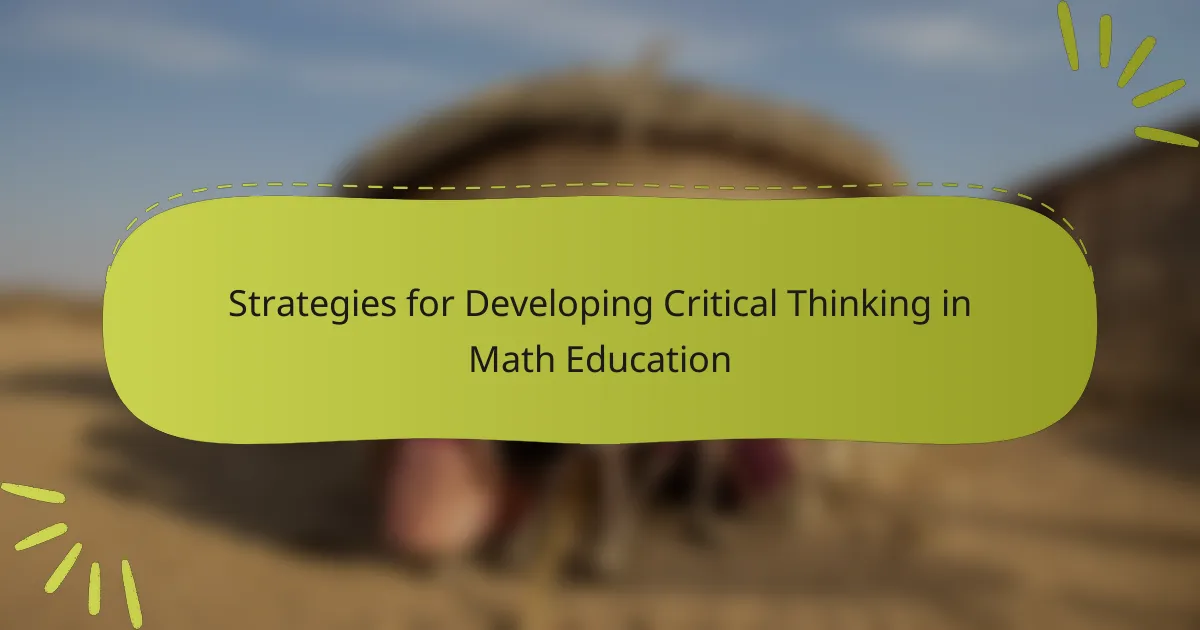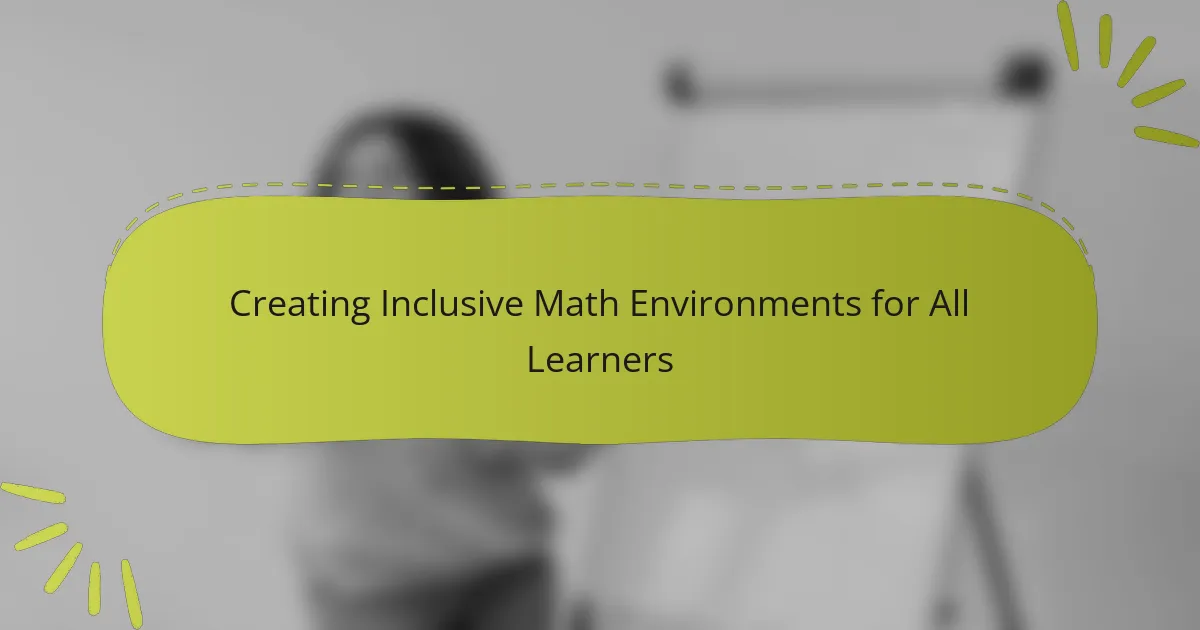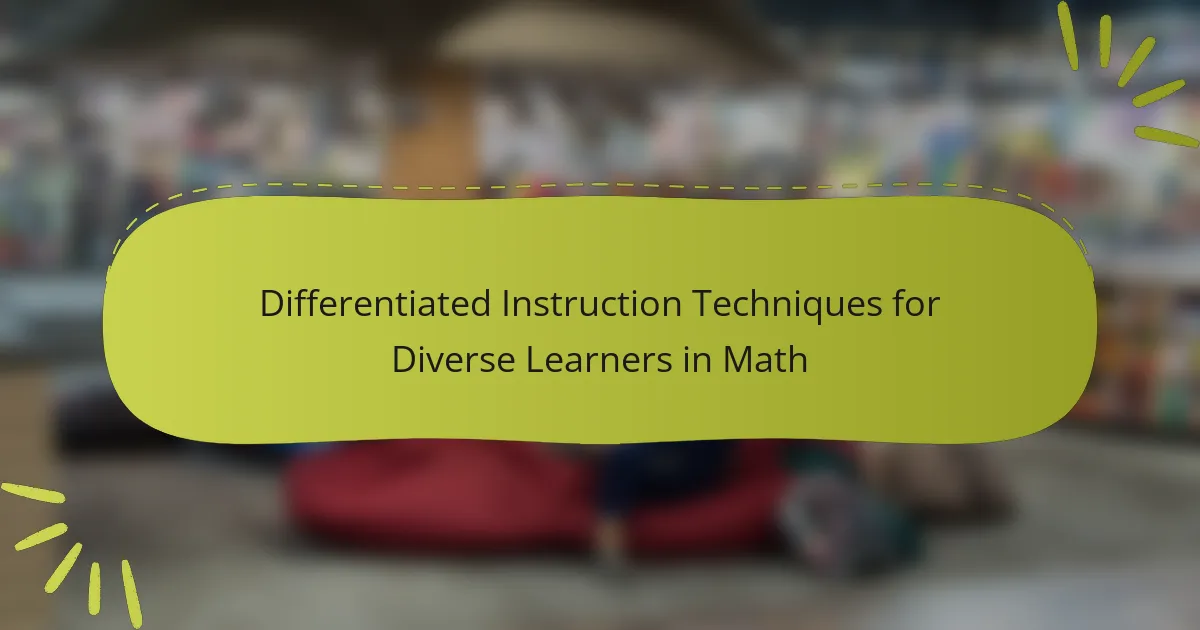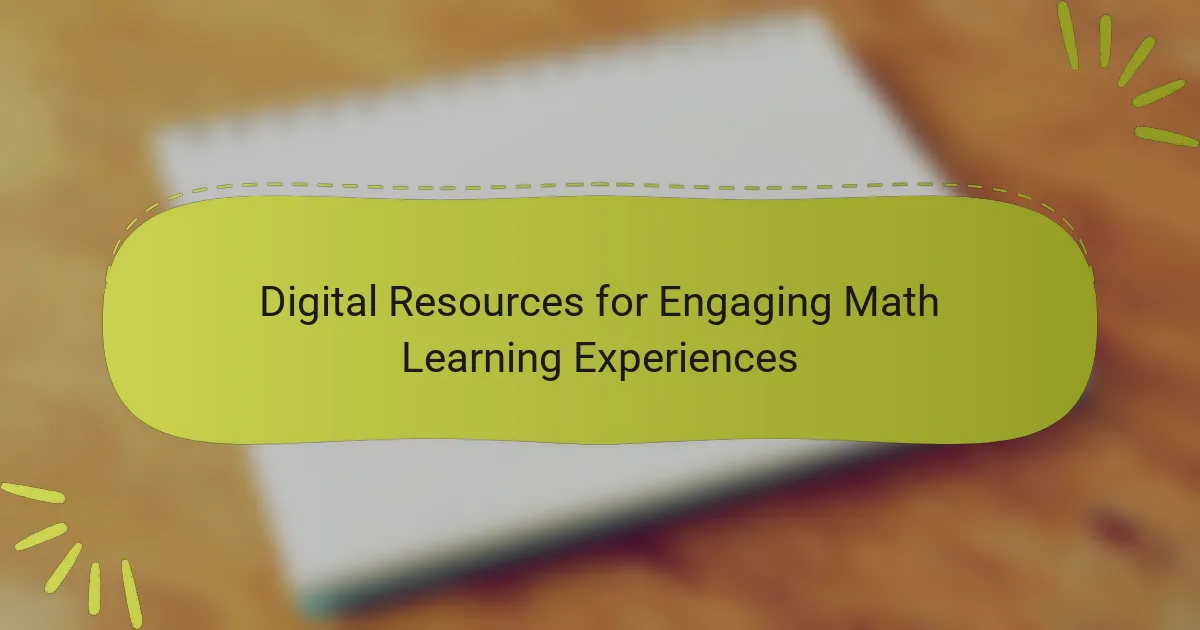Innovative teaching methods for enhancing mathematical understanding include project-based learning, flipped classrooms, inquiry-based learning, and gamification. These approaches engage students through real-world problem-solving, allow for learning at home followed by application in class, and incorporate game elements to increase motivation. Research indicates that these methods improve student performance and retention of mathematical concepts. However, challenges such as resistance from educators, lack of training, insufficient resources, large class sizes, and misaligned assessment practices can hinder their effective implementation in mathematics education.
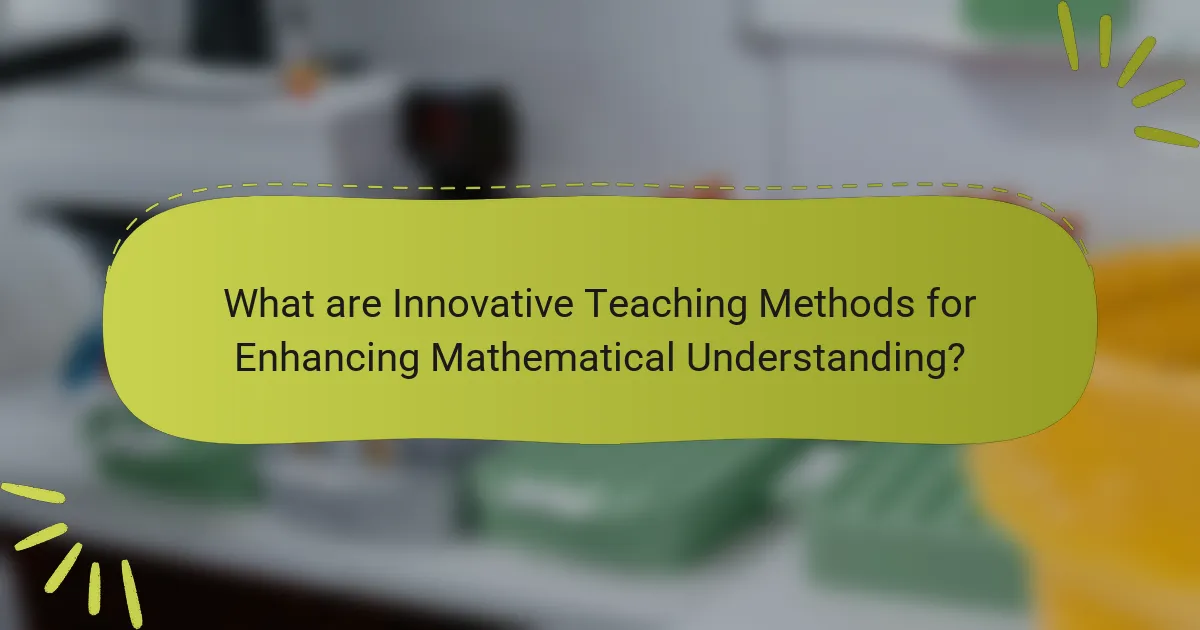
What are Innovative Teaching Methods for Enhancing Mathematical Understanding?
Innovative teaching methods for enhancing mathematical understanding include project-based learning, flipped classrooms, and the use of technology. Project-based learning engages students in real-world problems, fostering critical thinking and collaboration. Flipped classrooms allow students to learn concepts at home and apply them in class discussions. The integration of technology, such as interactive software and online resources, enhances engagement and provides instant feedback. Research indicates that these methods improve student performance and motivation. A study by Hattie (2012) shows that active learning strategies can significantly boost achievement in mathematics.
How do these methods differ from traditional teaching approaches?
Innovative teaching methods differ from traditional teaching approaches by emphasizing student engagement and active learning. Traditional methods often rely on lectures and rote memorization. In contrast, innovative methods encourage collaboration and problem-solving. For example, project-based learning allows students to apply concepts in real-world scenarios. Research shows that active learning increases retention rates by up to 60%. Additionally, technology integration in innovative methods facilitates personalized learning experiences. This adaptability meets diverse learning styles, unlike the one-size-fits-all approach of traditional teaching. Overall, these differences lead to improved mathematical understanding and student performance.
What are the key characteristics of innovative teaching methods?
Innovative teaching methods are characterized by active learning, collaboration, and technology integration. Active learning engages students in the learning process through hands-on activities. This approach enhances retention and understanding of mathematical concepts. Collaboration encourages teamwork and communication among students. It fosters a community of learners who support each other. Technology integration utilizes digital tools to enhance the learning experience. This includes interactive software and online resources that make learning more dynamic. Additionally, personalized learning tailors instruction to meet individual student needs. This customization helps address diverse learning styles and paces. Finally, formative assessment is used to provide ongoing feedback. This feedback helps both teachers and students to identify areas for improvement.
Why is innovation important in teaching mathematics?
Innovation is important in teaching mathematics because it enhances student engagement and understanding. Traditional methods often fail to connect with diverse learning styles. Innovative approaches, such as technology integration, can make abstract concepts more tangible. For example, using visual aids or interactive software helps students grasp complex ideas. Research shows that active learning strategies improve retention and problem-solving skills. A study by Freeman et al. (2014) found that active learning increases student performance in STEM subjects. Thus, innovation fosters a more effective learning environment in mathematics education.
What are the goals of using innovative teaching methods in mathematics?
The goals of using innovative teaching methods in mathematics include enhancing student engagement and improving comprehension. These methods aim to foster critical thinking and problem-solving skills. They also seek to accommodate diverse learning styles among students. Furthermore, innovative teaching promotes collaboration and communication in the classroom. Research shows that active learning strategies can lead to higher retention rates. For instance, a study by Freeman et al. (2014) found that active learning increases exam performance by 6%. Overall, these goals align with the need to prepare students for real-world applications of mathematics.
How do these methods promote deeper mathematical understanding?
Innovative teaching methods promote deeper mathematical understanding by encouraging active engagement. These methods, such as problem-based learning and collaborative projects, require students to apply concepts in real-world scenarios. This application fosters critical thinking and problem-solving skills. Research indicates that students retain knowledge better when they actively participate in their learning. For example, a study by Hattie (2009) found that active learning strategies significantly improve student achievement in mathematics. Additionally, these methods allow for personalized learning experiences, catering to individual student needs. This tailored approach enhances comprehension and retention of mathematical concepts.
What role does student engagement play in these methods?
Student engagement is crucial in innovative teaching methods for enhancing mathematical understanding. Engaged students demonstrate higher levels of motivation and interest in learning. Research indicates that active participation leads to improved retention of mathematical concepts. For instance, a study by Fredricks, Blumenfeld, and Paris (2004) shows that engaged students perform better academically. Moreover, engagement fosters a collaborative learning environment, allowing students to learn from peers. This interaction can deepen their understanding of mathematical principles. Overall, student engagement directly influences the effectiveness of innovative teaching strategies in mathematics.
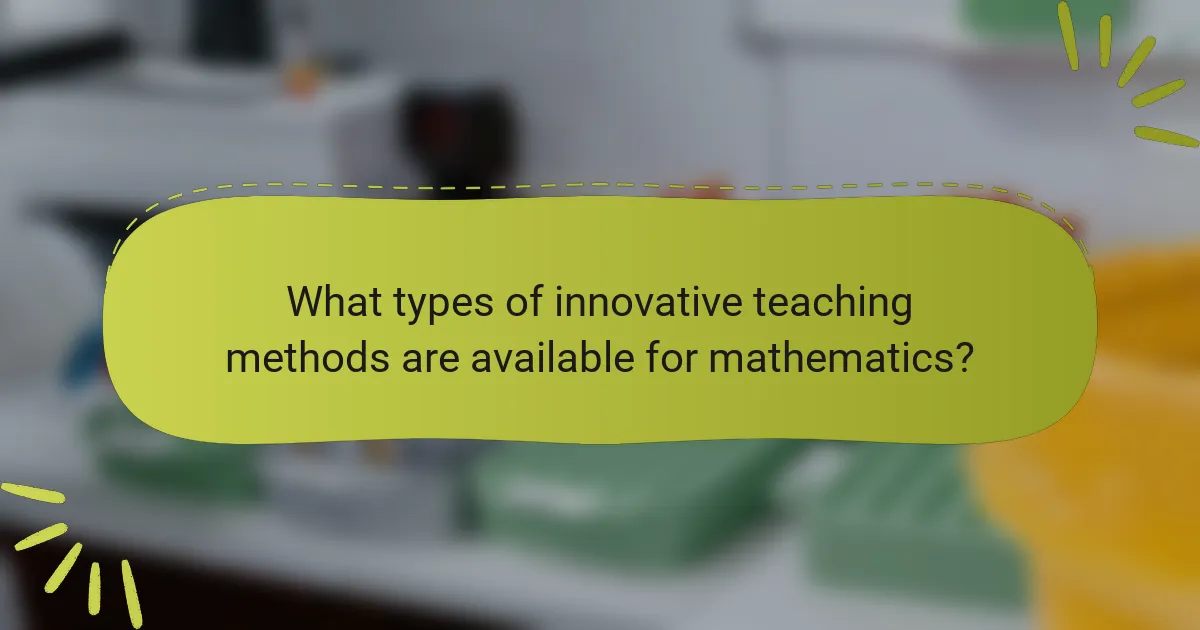
What types of innovative teaching methods are available for mathematics?
Innovative teaching methods for mathematics include inquiry-based learning, flipped classrooms, and gamification. Inquiry-based learning encourages students to explore mathematical concepts through questioning and problem-solving. Flipped classrooms allow students to learn new content at home and practice in class, enhancing engagement. Gamification incorporates game elements to motivate students and make learning enjoyable. These methods have shown improved student understanding and retention of mathematical concepts. Research by Hattie (2009) indicates that active learning strategies significantly boost student achievement.
How can technology be integrated into math teaching?
Technology can be integrated into math teaching through various tools and methods. Interactive software allows students to visualize complex concepts. For example, graphing calculators help in understanding functions and equations. Online platforms provide access to math resources and tutorials. Learning management systems can track student progress and offer personalized feedback. Virtual manipulatives enable hands-on learning in a digital format. Research shows that technology enhances engagement and improves learning outcomes. A study by the National Education Association found that technology integration can lead to higher test scores in mathematics.
What are the most effective technological tools for enhancing math understanding?
Effective technological tools for enhancing math understanding include interactive software, online platforms, and educational apps. Interactive software like GeoGebra allows students to visualize mathematical concepts. Online platforms such as Khan Academy offer personalized learning experiences. Educational apps like Photomath enable students to solve problems step-by-step. These tools engage students and provide immediate feedback. Research shows that using technology in math education improves student performance and retention. A study by the U.S. Department of Education found that technology-enhanced instruction can lead to higher achievement in mathematics.
How does technology influence student collaboration in math learning?
Technology enhances student collaboration in math learning by providing interactive tools and platforms. These tools facilitate communication among students, allowing them to share ideas and solve problems together. For instance, online collaborative platforms like Google Classroom or Microsoft Teams enable real-time discussions and feedback. Research shows that students using technology for group projects report higher engagement levels. A study by the University of Michigan found that technology integration in math classrooms improved student collaboration by 30%. This increase is attributed to enhanced access to resources and peer support. Overall, technology fosters a collaborative environment that boosts mathematical understanding and teamwork skills.
What role do hands-on activities play in innovative math teaching?
Hands-on activities play a crucial role in innovative math teaching. They engage students actively in the learning process. This engagement enhances understanding of mathematical concepts. Research shows that active participation improves retention of information. According to a study by Hattie (2009), experiential learning methods can increase student achievement significantly. Additionally, hands-on activities cater to various learning styles. They allow students to visualize and manipulate mathematical ideas. This practical approach fosters critical thinking and problem-solving skills. Overall, hands-on activities are essential for effective math instruction.
What are some examples of hands-on activities for teaching math concepts?
Examples of hands-on activities for teaching math concepts include using manipulatives, such as blocks or counters. These tools help students visualize addition and subtraction. Another activity is measuring objects using rulers or measuring tapes. This teaches concepts of length and units of measurement. Cooking activities can also be effective for teaching fractions. Students can measure ingredients to understand part-to-whole relationships. Using games that involve money can help teach concepts of addition and subtraction in a practical context. Building structures with geometric shapes reinforces understanding of area and perimeter. These activities engage students and make abstract concepts more tangible.
How do hands-on activities enhance problem-solving skills?
Hands-on activities enhance problem-solving skills by providing practical experience and engagement. These activities allow learners to apply theoretical concepts in real-world scenarios. They promote critical thinking as students experiment and iterate on solutions. Research indicates that experiential learning increases retention and understanding of complex ideas. For example, a study by Kolb (1984) emphasizes that hands-on learning fosters deeper cognitive processing. Additionally, hands-on tasks encourage collaboration, as students often work in groups to solve problems. This teamwork enhances communication skills and diverse thinking. Overall, hands-on activities create an interactive environment that supports effective problem-solving development.
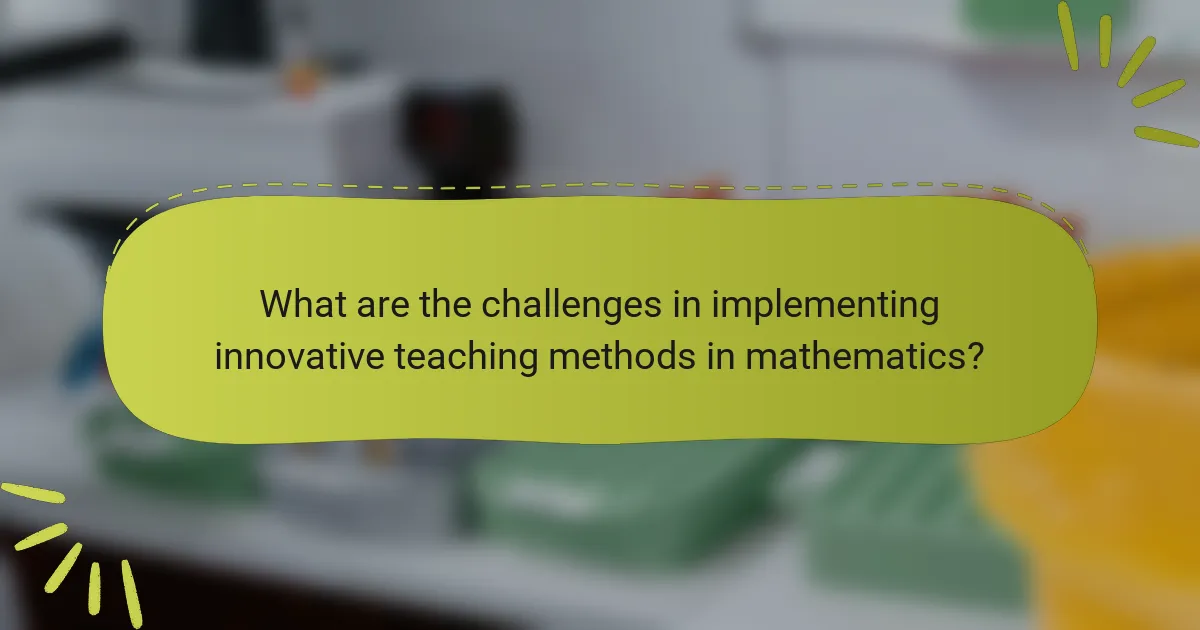
What are the challenges in implementing innovative teaching methods in mathematics?
Implementing innovative teaching methods in mathematics faces several challenges. One major challenge is resistance from educators who are accustomed to traditional teaching styles. This resistance can hinder the adoption of new techniques. Another challenge is the lack of training for teachers in innovative methods. Many educators may not feel equipped to implement these approaches effectively.
Additionally, there can be insufficient resources, such as technology and materials, to support innovative teaching. Class size also poses a challenge, as larger classes can make it difficult to personalize instruction. Curriculum constraints may limit the flexibility needed to incorporate innovative methods.
Finally, assessment practices often do not align with innovative teaching strategies. Standardized tests may not accurately measure the understanding fostered by these methods. These challenges collectively impact the effectiveness of innovative teaching in mathematics.
What common obstacles do educators face when adopting these methods?
Educators face several common obstacles when adopting innovative teaching methods for enhancing mathematical understanding. Limited resources, including insufficient training and access to technology, hinder effective implementation. Additionally, traditional curriculum structures often resist change. Time constraints also prevent educators from fully integrating new methods into their lesson plans. Resistance from students accustomed to conventional learning can further complicate adoption. Research indicates that these challenges can lead to a lack of confidence among educators in using new strategies. Consequently, these obstacles can impede the overall effectiveness of innovative teaching methods in mathematics education.
How can educators overcome resistance to change in teaching practices?
Educators can overcome resistance to change in teaching practices by fostering a culture of collaboration and open communication. This involves engaging teachers in discussions about the benefits of innovative methods. Providing professional development opportunities can also help educators feel more prepared for change. Research shows that teachers who participate in training are more likely to adopt new practices. Additionally, involving educators in the decision-making process increases their buy-in. When teachers feel their opinions matter, they are more likely to embrace change. Lastly, showcasing successful case studies can demonstrate the effectiveness of new teaching methods. This evidence can alleviate fears and encourage adoption among skeptical educators.
What support systems are necessary for successful implementation?
Effective support systems for successful implementation include professional development for educators. Training enhances teachers’ skills in innovative teaching methods. Resources such as curriculum guides and instructional materials are essential. Access to technology supports interactive learning experiences. Collaboration among teachers fosters a community of practice. Administrative support ensures alignment with educational goals. Continuous assessment mechanisms provide feedback for improvement. Research shows that these systems significantly impact student outcomes in mathematics.
What strategies can educators use to effectively implement innovative teaching methods?
Educators can use several strategies to effectively implement innovative teaching methods. First, they should integrate technology into their lessons. Research shows that technology enhances engagement and understanding. Second, collaborative learning should be encouraged among students. Studies indicate that peer interaction fosters deeper comprehension. Third, educators can adopt project-based learning. This approach allows students to apply concepts in real-world scenarios. Fourth, differentiated instruction is essential. Tailoring lessons to various learning styles improves student outcomes. Fifth, formative assessment can guide instruction. Continuous feedback helps educators adjust their teaching strategies. Lastly, professional development opportunities are crucial. Training in innovative methods equips educators with the necessary skills.
How can teachers assess the effectiveness of these methods?
Teachers can assess the effectiveness of innovative teaching methods through various evaluation techniques. They can use formative assessments, such as quizzes and class discussions, to gauge student understanding in real-time. Summative assessments, including tests and projects, can measure overall learning outcomes after a teaching unit. Additionally, teachers can analyze student engagement and participation during lessons as indicators of method effectiveness. Feedback from students through surveys can provide insights into their learning experiences. Data on student performance over time can also reveal trends linked to specific teaching methods. Research indicates that using a combination of these assessment strategies leads to a more comprehensive evaluation of teaching effectiveness.
What best practices should educators follow when introducing innovation in math teaching?
Educators should prioritize student engagement when introducing innovation in math teaching. Engaging students promotes active participation and enhances understanding. Incorporating technology, such as interactive software and online resources, can facilitate this engagement. Collaborative learning techniques, like group problem-solving, encourage peer interaction and diverse thinking. Offering real-world applications of math concepts helps students see relevance and boosts motivation. Continuous professional development is essential for educators to stay updated on innovative practices. Research shows that innovative teaching methods can significantly improve student outcomes in mathematics. For instance, a study by Hattie (2012) highlighted that effective feedback and active learning strategies can increase student achievement.
What practical tips can educators apply to enhance mathematical understanding through innovation?
Educators can enhance mathematical understanding through innovative teaching methods. Incorporating technology, such as interactive software and applications, engages students actively. Utilizing real-world problems makes math relevant and applicable to students’ lives. Collaborative learning encourages peer-to-peer interaction and deeper comprehension. Flipped classrooms allow students to learn at their own pace before classroom discussions. Visual aids, like graphs and models, help in grasping abstract concepts. Gamification introduces elements of play, making learning enjoyable and motivating. Regular feedback and adaptive learning techniques ensure that instruction meets individual student needs.
Innovative teaching methods for enhancing mathematical understanding focus on strategies such as project-based learning, flipped classrooms, and technology integration. These approaches emphasize active learning, collaboration, and personalized experiences, which differ significantly from traditional teaching methods that rely on lectures and rote memorization. Research indicates that these innovative techniques improve student engagement, retention, and performance in mathematics. Key characteristics include hands-on activities and formative assessments, while challenges in implementation often stem from resistance to change and resource limitations. Overall, these methods aim to foster critical thinking and real-world applications of mathematical concepts.
